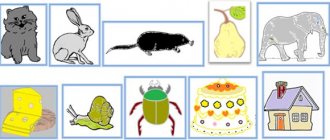Mini-lessons
Mini-classes of speech development are recommended by current programs to be used as special forms of speech development in work with children of the third year of life as often as possible (preferably daily), because they are relevant and correspond to the personality-oriented model of preschool education. This form of organizing speech activity can be initiated by the teacher, then they are provided for in the work calendar, or it can arise on the initiative of the children. The teacher must be prepared to guide such speech activity of the child.
The part of the word “mini”, according to A. Goncharenko, implies minimization:
- by the number of children who are simultaneously employed;
- by duration of organized activity;
- by the volume of content that is sold.
The number of mini-lessons and their content are determined by age characteristics. During the day, the teacher can organize himself or create conditions for children to self-organize dozens of individual, group and collective short-term mini-lessons, during which the planned topic will be implemented.
Conclusion on Chapter I
From the very first days of life until the end of the preschool period, children have the most important task - the formation and development of speech. Each year of a child’s life is divided into stages and at each of them speech is improved - from the first infant cry to the composition of complex sentences.
During early childhood, children undergo intensive speech development. During this time, the child’s active vocabulary exceeds the passive one; the child learns that each object has its own name; after he hears the word, he tries to repeat it; he learns to compose simple and complex common sentences.
The development of a child’s speech is closely related to communication with adults, and a lack of this communication can lead to delayed speech development and also affect the development of the baby’s psyche. A child’s communication with the people around him allows him to increase his passive and active vocabulary, improve his pronunciation and the content of his speech.
What should mom do?
By “infecting” the baby with positive emotions, the mother stimulates his interest in the outside world, and since the satisfaction of this interest involves the expenditure of physiological resources, she stimulates in a certain direction both metabolic processes and tissue differentiation in the body of her baby. On the contrary, by transmitting negative emotions to the baby, we suppress not only his interest in the outside world, but also certain biological processes of his body. It is no better when the adults around the child “infect” him with too strong affective emotions.
These energy-intensive emotions deplete the child’s nervous system and can lead to somatic diseases. An adult’s mechanical fulfillment of routine tasks, his indifferent, indifferent attitude towards a small child excludes the possibility of any kind of emotional contact at all. With such an adult, the child does not have the need to communicate, and therefore does not develop cognitive experience and does not form the necessary communicative-cognitive means. There is a threat of delayed mental development and disruption of the child’s further interaction with adults. The child’s brain develops incorrectly or is delayed in the absence or deficiency of external stimuli.
And, vice versa: interest in an adult, curiosity about the outside world and communicative-cognitive activity are caused and supported, as we have seen, by positive emotions emanating from an adult. Therefore, we can repeat once again that for infancy, the emotional communication of a child with an adult is not a luxury, but a primary necessity, a condition for the formation of his psyche according to the human social type. Depriving an infant of the emotional attention of an adult at this early age leads primarily to abnormal development of the child’s personality.
If parents notice trouble, and this is not one symptom, but several (lack of babbling, humming, change in voice, behavior), then you should contact a specialist. And then, along with speech therapy correction (massage, articulation gymnastics, stimulation of vocal reactions), drug treatment, physiotherapy, etc. are prescribed.
Introduction
Nowadays, the development of speech in children at an early age is one of the most important and main problems, since not all children develop speech according to established standards. This problem is considered most deeply by Gribova O.E. “What to do if your child does not speak / A book for those who are interested” [3] and Tkachenko T.A. “If a preschooler speaks poorly” [13].
Purpose of the work: to study the stages of development and methods of speech formation in young children.
Object of study: preschool children.
Subject of research: stages of speech development and methods of its formation.
Research methods:
- Research theoretical material on the topic of speech development in young children.
- Formation of a methodological piggy bank for speech development.
The role of the family in the development of a child’s speech
Everyone knows that it is the family that helps a child develop himself as an individual and explore the vast world, but the modern pace of life does not always allow parents to pay enough attention to their children.
At an early age, an adult provides solutions to three main psychological tasks:
- developing the child’s ability to imitate speech and distinguish speech sounds, which is the basis for understanding the meaning of what is said;
- increasing active and passive vocabulary;
- formation of the ability to use speech in communication.
Statistics show that in families where close relationships are formed, children grow up active and independent. In those families where there is a lack of attention in the early years of the child, in adolescence he becomes withdrawn and aggressive.
A child’s speech is formed through the speech of his family members. And only in an environment of live communication, he not only listens to others, but also joins in the dialogue.
Parents are required to know how important the speech of adults is for the formation of a child’s speech and how exactly to conduct a conversation with him. Adults must speak correctly, without distorting words, pronouncing each sound clearly, take their time, pronouncing endings correctly. Faking adult speech to resemble child speech slows down its development, because distorted words reach the child. It is especially important to pronounce unfamiliar, new and long words especially clearly.
Parents who decide to conduct speech development classes at home need to do the following exercises:
- 2-3 games to develop fine motor skills,
- articulation gymnastics (preferably 2 times a day),
- 2-3 games to develop auditory attention or phonemic awareness,
- 2-3 games for the formation of lexical and grammatical categories.
Conclusion on chapter 2
The most effective method of developing the speech of a young child is his participation in various types of activities.
Productive activities (appliqué, modeling, drawing) form a child’s idea of the shape, color or properties of a particular object. During the lessons, the child develops imagination, fine motor skills and, most importantly, speech activity. The child discovers a lot of new things and wants to know about everything, this is how the child’s dialogue with an adult or teacher is formed.
Playful activities allow the child to improve not only the coordination of movements while playing with objects, but also the quality and quantity of words in his active vocabulary, as the child gives a name to the object/toy, comes up with a situation in which he is and explains his actions. Thus, we can say that play is a fruitful way to develop speech in children.
All the methods we propose contribute to the development and improvement of the child’s speech, and also help prevent its delay.
Mini-lesson structure
A. Krikun recommends including the following in the structure of mini-lessons:
- joint musical congratulations, which are aimed at developing a communicative culture, with elements of psycho-gymnastics;
- elements of visual activity, which are accompanied by verbal commentary.
All components of such activities can be united by a single plot, the basis of which is a certain lexical topic, for example, “Transport”, “Our toys”, “How the little bunny looked for its mother”, etc., the application of which can be various tasks and activities. Each topic requires the selection of certain material. It is advisable to combine outdoor, board, finger games, dances, songs, poetic material, health exercises, fairy tales; You can use elements of various developmental techniques.
Mini-lessons with kids end with a joint summing up and relaxation exercises.






